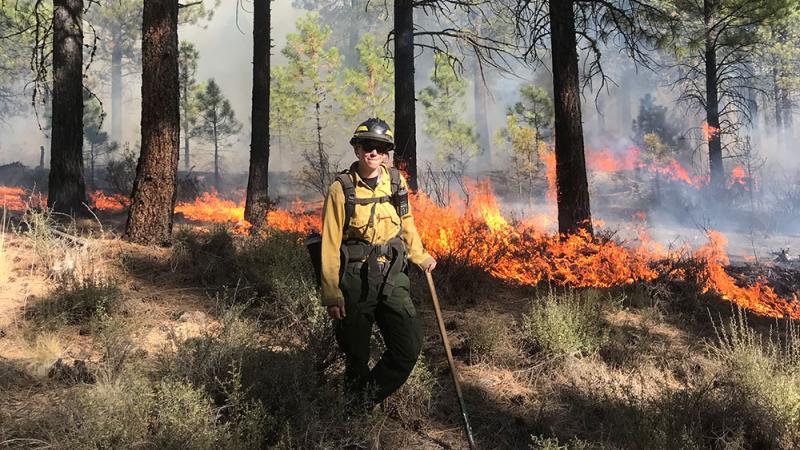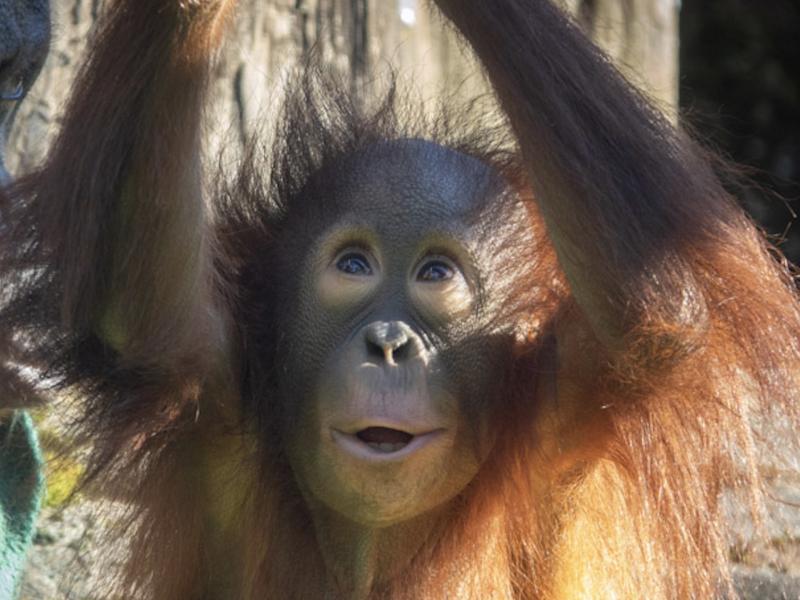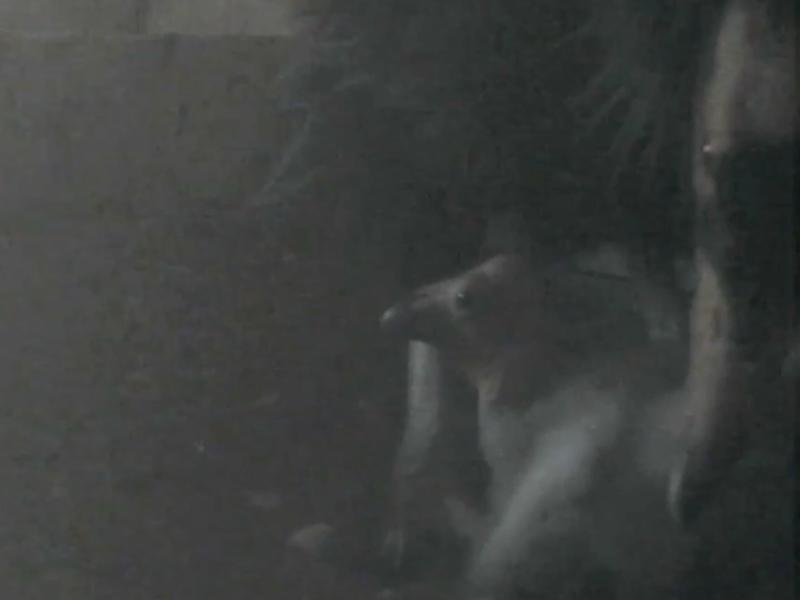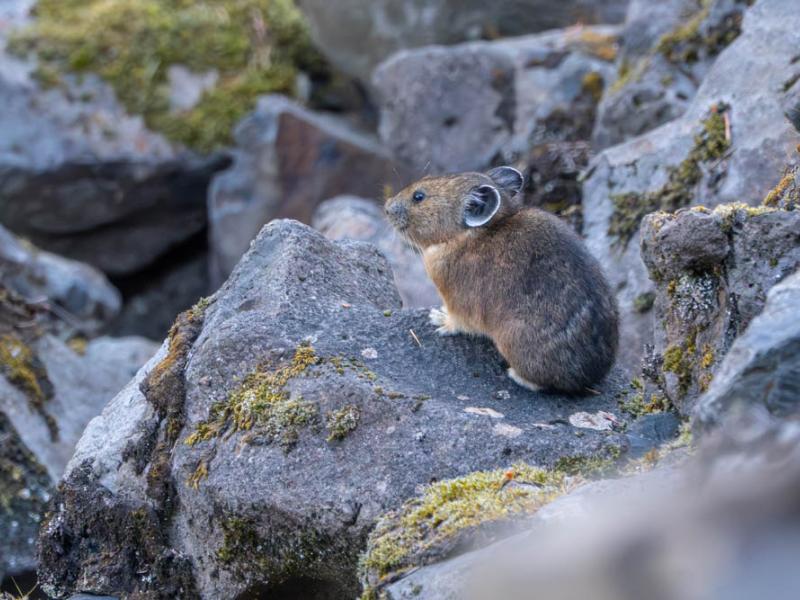Wildlife and wildfire: A Q&A with Katie Sauerbrey

Fire is a natural process in Oregon's forests, where thousands of species depend on periodic burning to provide food and habitat. But a century of tampering with natural fire cycles, combined with the effects of climate change, has changed how fires burn — and how we perceive them. Katie Sauerbrey is The Nature Conservancy's fire manager for the state of Oregon, and preserve manager for a fire-dependent ecosystem in Eastern Oregon. We spoke with her about the relationship between fire and wildlife.
OZ: How is fire beneficial to forests and the wildlife that live in them?
K: Fire is like a reset switch. When fire burns through a forest, it can act as a vacuum, cleaning out the buildup of dead sticks and dead vegetation, and it can start a new cycle. Fire creates homes and habitat for wildlife. One example is woodpeckers. They live in dead trees, which often are created by fire. Those same woodpeckers need insects and their larvae to eat, and when you have a healthy functioning forest, you're going to have more of those bugs. Deer and elk need open areas to bed down, graze and sleep, and fire can create those areas for them. Fire burns the shrubs and the grasses that deer and elk eat, and it revitalizes them and makes them more nutritious for those animals.
OZ: How do fires burn differently in different parts of Oregon?
K: Every forest in Oregon has a natural fire cycle that it needs to stay healthy. In our Eastern Oregon forests, fires burn roughly every three to 30 years. And in the wetter forests in Western Oregon, you would see fire naturally occurring every 100 to 500 years.
OZ: How have humans changed the way wildfires burn?
K: Oregon forests have had fire for thousands of years, both through lightning and through cultural ignitions by indigenous peoples. Over the last 100 to 150 years, humans have kind of tampered with the natural fire cycles. The old thinking was that we don't want to burn up our timber because it's building our houses and making us money, so we're going to put these fires out as quickly as possible and keep them as small as possible. But we didn't understand the ramifications of missing the natural fire cycles.
Climate change packs a double punch in terms of forests and fire. Warmer temperatures and drought often equal larger, more intense fires — especially if they're in areas that have missed the natural fire cycle and have dense forest stands. Climate change is thought to make it more difficult for forests to recover from wildfires. And it's something that we're going to need to be really proactive about addressing.
OZ: What is TNC doing to restore natural fire cycles?
K: We have a group of experts that can go into an area and make a very specific plan on how to intentionally reintroduce fire to that forest, to mimic what the natural fire would have looked like. The objectives also include making sure that everybody's safe and ensuring habitat for plants and animals. It includes very specific weather parameters paired with computer modeling. The modeling also gives us a better understanding of what a fire is going to do in different scenarios, which ultimately makes firefighters safer in doing their jobs. So when you get to the day that you're going to light the match, everything's already planned.
We prioritize the eastern dry forests for controlled burning, because those are the forests that have missed the natural fire cycle. It sets that reset switch, revitalizing fire's role in that system. And it makes it so that when you have future fires, whether it's a controlled burn or a wildfire, it's going to burn more in tune with the natural fire cycle.
OZ: How has this mitigation been working at the preserve that you manage?
K: The preserve I manage for The Nature Conservancy is called Sycan Marsh Preserve. We have thousands of acres of dry forest that is dependent on fire. We've been able to do multiple controlled burns to get the fire cycle back in place. And when you look at those areas, you start to see more abundance, more plants and animals that belong in that forest. We're seeing more wildflowers, and the deer and elk really like those areas because they have so much more food. It's just like a bustling, healthy forest.
OZ: What gives you hope about the work you're doing?
K: Like the wildlife, we are a part of these forests too. We have homes in them, we work and play in them. And so there has to be a balance there. I live here, and the thing I know about Oregon is that people love their forests. Over the last few years, I have seen Oregonians learning more about the natural role of fire in our forests, being enthusiastic about the health of Oregon forests and asking the same questions you're asking about how to make sure our forests are healthy. And when the majority of people in our state start to ask those questions, and start to demand that we care for the health of our forests, it gives me hope that we're going to be able to make progress and actually effect change.
More News

Jolene turns 2: Zoo to celebrate orangutan's 2nd birthday
The littlest member of the orangutan family is celebrating a big milestone this week: Jolene will turn 2 on Saturday.April 12, 2024

Seven chicks and counting: Zoo welcomes first condors of 2024
Seven fluffy chicks hatched last month at the Oregon Zoo’s Jonsson Center for Wildlife Conservation.April 5, 2024

Zoo seeks pika watchers for summer season
The zoo is recruiting volunteers to seek out one of the Columbia River Gorge’s fluffiest residents: the American pika.April 3, 2024

